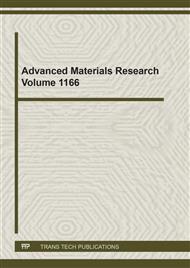[1]
D. C. Larbalestier et al., Strongly linked current flow in polycrystalline forms of the superconductor MgB2,, Nature, 2001,.
DOI: 10.1002/chin.200125013
Google Scholar
[2]
J. Nagamatsu, N. Nakagawa, T. Muranaka, Y. Zenitani, and J. Akimitsu, Superconductivity at 39 K in magnesium diboride,, Nature, vol. 410, no. March, p.63–64, 2001,.
DOI: 10.1038/35065039
Google Scholar
[3]
R. Gladyshevskii and P. Galez, Crystal Structures of High-Tc Superconducting Cuprates,, in Handbook of Superconductivity, (2000).
DOI: 10.1016/b978-012561460-3/50009-6
Google Scholar
[4]
B. Raveau, C. Michel, B. Mercey, J. F. Hamet, and M. Hervieu, Crystal chemistry of superconducting copper oxycarbonates,, J. Alloys Compd., 1995,.
DOI: 10.1016/0925-8388(95)01679-1
Google Scholar
[5]
M. Atikur Rahman, A Review on Cuprate Based Superconducting Materials Including Characteristics and Applications,, Am. J. Phys. Appl., 2015,.
Google Scholar
[6]
J. Kortus, I. I. Mazin, K. D. Belashchenko, V. P. Antropov, and L. L. Boyer, Superconductivity of metallic Boron in MgB2,, Phys. Rev. Lett., vol. 86, no. 20, p.4656–4659, (2001).
DOI: 10.1103/physrevlett.86.4656
Google Scholar
[7]
A. Serquis et al., Hot isostatic pressing of powder in tube MgB2 wires,, Appl. Phys. Lett., 2003,.
Google Scholar
[8]
C. U. Jung et al., High-pressure sintering of highly dense MgB2 and its unique pinning properties,, Curr. Appl. Phys., 2001,.
Google Scholar
[9]
B.-H. Jun and C.-J. Kim, The effect of heat-treatment temperature on the superconducting properties of malic acid-doped MgB 2 / Fe wire,, Supercond. Sci. Technol., vol. 20, no. 10, p.980–985, Oct. 2007,.
DOI: 10.1088/0953-2048/20/10/015
Google Scholar
[10]
J. H. Kim et al., The effects of sintering temperature on superconductivity in MgB 2 /Fe wires,, Supercond. Sci. Technol., vol. 20, no. 5, p.448–451, May 2007,.
Google Scholar
[11]
J. H. Kim et al., Correlation between doping induced disorder and superconducting properties in carbohydrate doped MgB2,, J. Appl. Phys., vol. 104, no. 6, p.063911, Sep. 2008,.
DOI: 10.1063/1.2980275
Google Scholar
[12]
M. I. Maulana et al., Morphological and resistance properties analysis of MgB2 superconducting wires prepared by industrial drawing process,, 2020,.
Google Scholar
[13]
H. Kumakura, A. Matsumoto, T. Nakane, and H. Kitaguchi, Fabrication and properties of powder-in-tube-processed MgB2 tape conductors,, Physica C: Superconductivity and its Applications. 2007,.
DOI: 10.1016/j.physc.2006.12.017
Google Scholar
[14]
A. Imaduddin, S. D. Yudanto, M. E. H. Rasyadi, Y. Nakanishi, and M. Yoshizawa, Possibility of the Higher Critical Temperature on MgB2 Superconductor Synthesized by Powder-In-Sealed-Tube Method,, J. Low Temp. Phys., vol. 195, no. 5–6, p.460–473, 2019,.
DOI: 10.1007/s10909-019-02184-9
Google Scholar
[15]
N. Varghese, K. Vinod, A. Rao, Y. K. Kuo, and U. Syamaprasad, Enhanced superconducting properties of bulk MgB2 prepared by in situ Powder-In-Sealed-Tube method,, J. Alloys Compd., vol. 470, p.63–66, 2009,.
DOI: 10.1016/j.jallcom.2008.03.056
Google Scholar
[16]
S. D. Yudanto, A. Imaduddin, B. Kurniawan, and A. Manaf, Formation of polycrystalline MgB2 synthesized by powder in sealed tube method with different initial boron phase,, in AIP Conference Proceedings 1945, 2018, no. April,.
DOI: 10.1063/1.5030249
Google Scholar
[17]
K. Vinod and U. Syamaprasad, Studies on development of MgB2 superconductor with improved infield critical current density,, Adv. Mater. Res., vol. 117, p.63–68, 2010,.
Google Scholar
[18]
E. Aksu, Study of MgB2 phase formation by using XRD, SEM, thermal and magnetic measurements,, J. Alloys Compd., vol. 552, p.376–381, 2013,.
DOI: 10.1016/j.jallcom.2012.11.088
Google Scholar
[19]
J. H. Ahn and S. Oh, Pore structures and grain connectivity of bulk MgB2,, Phys. C Supercond. its Appl., 2009,.
Google Scholar
[20]
A. Kikuchi, Y. Iijima, Y. Yoshida, N. Banno, T. Takeuchi, and K. Inoue, Microstructure and superconductivity of MgB2 synthesized by using Mg-based compound powders,, 2004,.
DOI: 10.1016/j.physc.2003.11.080
Google Scholar
[21]
Q. Z. Shi, Y. C. Liu, Q. Zhao, and Z. Q. Ma, Phase formation process of bulk MgB2 analyzed by Differential Thermal Analysis during sintering,, J. Alloys Compd., 2008,.
DOI: 10.1016/j.jallcom.2007.04.045
Google Scholar
[22]
S. K. Chen et al., Structural and superconducting property variations with nominal Mg non-stoichiometry in MgxB2 and its enhancement of upper critical field,, Adv. Funct. Mater., 2008,.
DOI: 10.1002/adfm.200700254
Google Scholar
[23]
C. U. Jung et al., Effects of unreacted Mg impurities on the transport properties of MgB2,, Phys. C Supercond. its Appl., vol. 377, no. 1–2, p.21–25, 2002,.
Google Scholar
[24]
C. U. Jung and S. I. Lee, Effect of unreacted Mg on the pinning properties of MgB2,, J. Magn. Magn. Mater., 2007,.
Google Scholar
[25]
Y. Hou et al., Synthesis of High Critical Current Density MgB2 Bulks by an Improved Mg-diffusion Method,, Xiyou Jinshu Cailiao Yu Gongcheng/Rare Met. Mater. Eng., vol. 47, no. 5, p.1406–1410, 2018,.
DOI: 10.1016/s1875-5372(18)30142-5
Google Scholar
[26]
S. B. Güner et al., Investigation on superconducting and magnetic levitation force behaviour of excess Mg doped-bulk MgB2 superconductors,, Cryogenics (Guildf)., vol. 101, no. August 2018, p.131–136, 2019,.
DOI: 10.1016/j.cryogenics.2019.05.002
Google Scholar
[27]
P. Kováč et al., Structure and properties of barrier-free MgB2 composite wires made by internal magnesium diffusion process,, J. Alloys Compd., vol. 829, 2020,.
DOI: 10.1016/j.jallcom.2020.154543
Google Scholar


